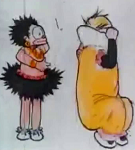Ever wondered how animation found its way in the reality? Ever thought the forms in which it all started? It isn’t recent that animation has found its existence and potential to create a world of its own. It all started years back when colours were not the priority; the world looked black and white, but meaningful and fun. Animated movies were created years back with what may be termed as obsolete technology. There were people who stood out and took risk of doing something out of the conventional way, these people suffered failure too when audience did not accept animation initially. Hats-off to them for not stopping, they did what we have today—inception of animation. No matter what the quality of the animation, the content was well liked by people which encourage many to develop animated characters and movies. The start might not be in the long form i.e. full-length movies, but many short films were created in those days to test the water. These films were rich with content but only few experiments were successful.
Few such short animated movies that did good in their days are listed:
Fun In A Bakery Shop (1902)
It was a short film which was directed by Edwin S. Porter. Surprisingly, the length of the film was just one minute and 30 seconds long and contained some experimental use of stop-motion animation. The story focuses on a baker who spies a rat and tries to kill it with various methods including throwing a handful of dough at the rat. The baker also makes busts of various celebrities of those days like Buffalo Bill, Admiral Schley, and ultimately a comical Irishman with a cocked hat, clay pipe, and Donegal whiskers. Various comical scenes are covered in the movie which makes it a hilarious lot including the one where he throws up white flour at another baker’s face who ends up on the floor in a heap.
The Haunted Hotel (1907)
The film is a mixture of live-action and stop-motion short film which is also a silent comedy made by James Stuart Blackton. The length of the movie is equally short as it will last only for approximately seven minutes. The story focuses on a tourist who visits a mysterious inn which is occupied by unknown faces. Blackton is said to be the first ones who adopted lightning-sketch and trick photography. The story focuses on an old hotel which is brought to life through animation. The tourist is tormented by various mysterious happenings. Such as objects are mysteriously dragged around the room, the breakfast is served itself, a miniature figure manifests out of the pitcher, and much more.
A lot of techniques of trick photography have been used to cut through the footage and overlay the next to convey the presence of ghosts. With the use of canted photography and overstated stage acting, the room seems like it is tilting from side to side, and towards the end, the use of miniatures depicts the traveller is taken by a monstrous giant.
Long Live the Bull (1926)
This is a clay animation film, commonly called as claymation, which is made by Ralph Sunn. In layman’s language, the entire film was made out of clay. Originally, it was a silent film, but over the years, many have added music to make it more interactive. The story focuses on a guitar playing Barcelona man who is in love with a woman and the only way he can win her is through winning a bull-fight. In the film, he is shown trying to win a girl by fighting a bull—who is a friend at one moment and enemy at another. A guitar playing Barcelona man is in love with a woman, and she says the only way he can attain her love is if he faces off with a bull. But things do not go as planned.
This film is termed as the oldest surviving clay film today.
Pauvre Pierrot (1892)
It is a French short animated film which was directed by Charles-Emile Reynaud. The film comprises of 500 individually painted images and originally lasted for 15 minutes. It is said to be the first animated films ever made alongside Le Clown et ses chiens and Un bon bock in the year 1892. The combined performance of all three films was known as Pantomimes Lumineuses. Pauvre Pierrot was the first film to be demonstrated at the Charles-Emile Reynaud’s Théâtre Optique, a device that projects images on a screen. Neither Un bon bock nor Le Clown et ses chiens survived, but Pauvre Pierrot does. The story focuses on Arlequin who comes to see his lover Columbine one night. But Pierrot arrives and knocks at the door making Columbine and Arlequin hide. Pierrot sings for her but Arlequin scares him away.
Little Nemo (1911)
Little Nemo is a silent animated short film. The comic strip is made by the American cartoonist Winsor McCay. This animation was the centrepiece of a 10-minute film entitled Winsor McCay, the Famous Cartoonist of the N.Y. Herald and His Moving Comics. This film is a mixture of live action, animated sequences and drawing demonstrations. The story is about a boy who dreams wild but wonderful things each night and wakes up in the last panel of each episode. However, the movie starts off with McCay betting his friends that he can make his drawing move. In the end, the animated sequence is briefly shown in which Little Nemo dances, fights, and interacts with his friends.
Each of these super-short films bring a unique angle to the world of animation and teaches us how it’s always a learning process till one grows and learns to evolve. Animation too has evolved and will continue to do so, but the content will still be loved and looked forward to.





